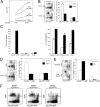CX3CR1+ CD8alpha+ dendritic cells are a steady-state population related to plasmacytoid dendritic cells
- PMID: 20679228
- PMCID: PMC2930429
- DOI: 10.1073/pnas.1001562107
CX3CR1+ CD8alpha+ dendritic cells are a steady-state population related to plasmacytoid dendritic cells
Abstract
Lymphoid organs are characterized by a complex network of phenotypically distinct dendritic cells (DC) with potentially unique roles in pathogen recognition and immunostimulation. Classical DC (cDC) include two major subsets distinguished in the mouse by the expression of CD8alpha. Here we describe a subset of CD8alpha(+) DC in lymphoid organs of naïve mice characterized by expression of the CX(3)CR1 chemokine receptor. CX(3)CR1(+) CD8alpha(+) DC lack hallmarks of classical CD8alpha(+) DC, including IL-12 secretion, the capacity to cross-present antigen, and their developmental dependence on the transcriptional factor BatF3. Gene-expression profiling showed that CX(3)CR1(+) CD8alpha(+) DC resemble CD8alpha(-) cDC. The microarray analysis further revealed a unique plasmacytoid DC (PDC) gene signature of CX(3)CR1(+) CD8alpha(+) DC. A PDC relationship of the cells is supported further by the fact that they harbor characteristic D-J Ig gene rearrangements and that development of CX(3)CR1(+) CD8alpha(+) DC requires E2-2, the critical transcriptional regulator of PDC. Thus, CX(3)CR1(+) CD8alpha(+) DC represent a unique DC subset, related to but distinct from PDC. Collectively, the expression-profiling data of this study refine the resolution of previous DC definitions, sharpen the border of classical CD8alpha(+) and CD8alpha(-) DC, and should assist the identification of human counterparts of murine DC subsets.
Conflict of interest statement
The authors declare no conflict of interest.
Figures




References
-
- Sapoznikov A, Jung S. Probing in vivo dendritic cell functions by conditional cell ablation. Immunol Cell Biol. 2008;86:409–415. - PubMed
-
- Shortman K, Naik SH. Steady-state and inflammatory dendritic-cell development. Nat Rev Immunol. 2007;7:19–30. - PubMed
-
- Dudziak D, et al. Differential antigen processing by dendritic cell subsets in vivo. Science. 2007;315:107–111. - PubMed
Publication types
MeSH terms
Substances
Associated data
- Actions
Grants and funding
LinkOut - more resources
Full Text Sources
Other Literature Sources
Molecular Biology Databases

